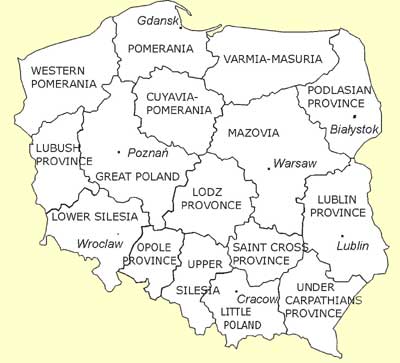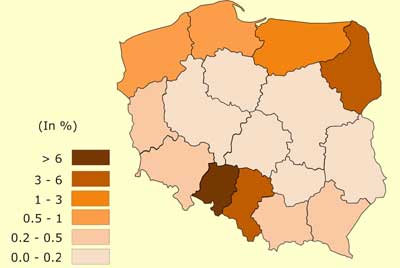
| Spring - Summer 2004 |
| Language minorities in Poland at the moment of accession to the EU, by Marta Moskal | ||||
Summary 2. Linguistic situation in Poland 5. Language-related legislation 6. Use of languages in other public
spheres 7. Conditions of existence of minority and regional languages In Poland, as well as in other European countries, what is being observed nowadays is a renaissance of regional cultures and attitudes favourable towards languages of ethnic minorities and regional communities. The Republic of Poland has been for a few years now a member of the Council of Europe and on the 1st of May 2004, together with several other Eastern and Central European states it became a member of the EU. The European Union’s policy on languages recognises all languages as equal and both minority and regional languages are legally protected. After admission of Poland to the European Union, the Polish language has obtained the status of its official language. At the same time, the catalogue of minority and regional languages has significantly increased. It is a huge financial and legal burden, both for the whole Union and for its member-states. On the other hand Poland is legally bound to observe European standards of protection and promotion of minority and regional languages. Poland, as well as most of the new member states, is a multiethnic and a multilingual country. Despite slender population of people who are ethnically non-Polish and do not speak Polish as their mother tongue (they are estimated at approximately 1.2 million people, which constitutes about 3 per cent of all inhabitants of the country), Poland has a considerable number of minority groups whose native language is other than the official language. 2. Linguistic situation of Poland The languages which are used by the citizens of the Republic of Poland have a varying socio-linguistic status. There is among them the Kashubian language on the one hand, doubtlessly the most vivid regional language and mother tongue, and the Karaim or the Armenian language (Grabar - the language of Old Armenians) on the other hand – languages of ethnic and religious minorities existing in fact only in the written form and used by no more than just a few people. Separately from these should be considered dialects of the Polish language, those used commonly in particular regions, such as the Silesian dialect of Polish – mother tongue of Silesians, as well as of those declaring German nationality, or the Spis-Orava dialects, which are also mother tongue of Slovakian minority living in Polish Spis and Orava. It should be pointed out that there are communities residing in distinct geographical regions, for example Silesians in Silesia, which demonstrate a weaker sense of ethnic, cultural and linguistic identity than either the minorities inhabiting territories which are not so clearly defined, for example Kashubs or Byelorussians (White Russians), or those living in the diaspora and not occupying a distinct territory, such as Ukrainians and Ruthenians after the post-war displacements. In terms of the linguistic background in Poland, Polish is the official language of the country. However, Poland also has 16 indigenous minority languages (which means languages that are "traditionally used within a given territory of a State by nationals of that State who form a group numerically smaller than the rest of the State’s population and different from the official language of that State".(1) This approach, which excludes the language of immigrants, requires however considering the history of Poland from linguistic point of view). Within the territory of the Republic of Poland the following languages of ethnic minorities, grouped in three big linguistic categories, can be distinguished:(2) 1) Regional languages: languages used by particular indigenous ethnic groups, often closely related to the languages of the majority (which makes their linguistic status a debatable issue) or being dialects of official languages. They do not have the status of official languages. In this group four regional languages of the territory of Poland can be included: Kashubian, Silesian, Ruthenian/Lemkish, and Wilamowicean.(3) 2) Minority languages: languages of national groups whose state is beyond the territory of a given country and therefore possess their normalized standard varieties which are official languages of other countries. Seven languages represent this type in Poland: Byelorussian, Czech, German, Lithuanian, Russian, Slovak, and Ukrainian. In this group languages without the status of official state languages -not genetically related to the language of majority and used by indigenous groups inhabiting their ethnic territory on the territory of another state- are also included. 3) Diaspora languages: used by ethnic and national groups not possessing their own territory in Europe, living among majority groups for so long that they begin to resemble indigenous people. In Poland languages include: Gypsy (Romany dialects), Hebrew and Yiddish, Karaim, Armenian. It should also be noted that the Hebrew language taught at Jewish school in Poland is recognized as the official language in the state of Israel and therefore it should be considered in the presented classification as a minority language. Table 1. enumerates these languages, provides selected information on their linguistic relationships, indicates estimated population figures, as well as localises them territorially (compare with Fig 1., 2., 3.). Figure
1. New administrative division of Poland
Figure
2. Non-polish nationality declared by citizens
Source: Author's own map based on the 2002 census. Table 1. Indigenous minority and regional languages in Poland
Source: Author’s own table based on the governmental estimations. |

